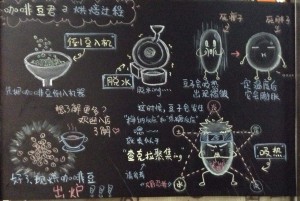# Coffee Encyclopedia # two pictures to tell you about coffee beans from fruit to beans
Every year in October, coffee from all over the world slowly enters the ripening period, and every step of this red fruit will affect its taste from the moment it is picked.

Coffee bean production process
Step.1 picking. Generally speaking, fruits that turn red can be picked, but in some places, there is no strict quality control, and some unripe fruits will also be picked. This is the most common defective bean, white bean, when we deal with coffee beans.
Step.2 to remove the pulp, this is what we often call coffee treatment: washing, drying.
Washing type, that is, after the fresh fruit is fermented in water, part of the pericarp is removed; the drying type, such as sun beans, that is, after the fresh fruit is fully dried, the peel will separate and fall off by itself, and then use a sheller to remove the shell.
Generally speaking, washed beans will be very refreshing, without too much miscellaneous flavor, while dried beans will have more flavor changes.
Step3. After treatment, we got a lot of green coffee beans. After grading and screening, different grades of beans are obtained, and the coffee roaster will determine the different baking depth according to the characteristics of these beans.
Step4, this step, naturally is baking, there are many ways to bake, you can directly stir-fry beans, or use hand network baking, professional barista, of course, is to use a professional coffee roaster.

Coffee bean baking process
Step5. Take the professional coffee roaster as an example, the first thing is to preheat the machine first. When the temperature in the machine reaches a certain temperature, the beans begin to drop. After the coffee beans are dehydrated, the temperature in the chamber continues to rise. With the increase of temperature, besides the change of color, the volume will also change accordingly. With the Mena reaction and caramelization reaction, the coffee will go through the first explosion, the first explosion density, the end of the first explosion, the second explosion, the second explosion, and the end of the second explosion. The coffee roaster decides to come out of the oven differently according to the beans. After the beans are cooled, they are ground into powder, which is the raw material from which we begin to brew coffee-coffee powder.
Important Notice :
前街咖啡 FrontStreet Coffee has moved to new addredd:
FrontStreet Coffee Address: 315,Donghua East Road,GuangZhou
Tel:020 38364473
- Prev

Entry-level coffee beans lemon queen Ethiopia yega sherfie
Ye Jia Xue Fei as an entry-level coffee beans, not to say how inferior it is, but such a price, such a distinct character and taste, as long as it is not too bad baking bean division, you know, immediately after the explosion, you can immediately drink the first cup of quality coffee with character. The beans of Yega Shefi Coffee are divided into 5 grades, and the more common beans are Ye.
- Next

Understand the types of boutique coffee beans world-famous boutique coffee beans and their origin distribution map
World Fine Coffee Map Latin American Coffee beans (Central and South America) Brazil: Santos, Bahia, Cerrado, Mogiana Mexico: Coatepec, Huatusco, Orizaba, Maragogype, Tapanchula, H
Related
- Guji coffee producing area of Guji, Ethiopia: Humbela, Shakiso, Wulaga
- What is the most expensive variety of Qiloso in BOP multi-variety group?
- How to store the coffee beans bought home?
- Why are Yemeni coffee beans so rare now?
- Ethiopian Sidamo all Red Fruit Sun Sun Santa Vini Coffee beans
- SOE is mostly sour? What does it mean? Is it a single bean? what's the difference between it and Italian blending?
- Is Italian coffee beans suitable for making hand-brewed coffee?
- How to choose coffee beans when making cold coffee? What kind of coffee beans are suitable for making cold coffee?
- Just entered the pit to make coffee, what kind of coffee beans should be chosen?
- Can only Japan buy real Blue Mountain Coffee? What are authentic Jamaican Blue Mountain coffee beans?

